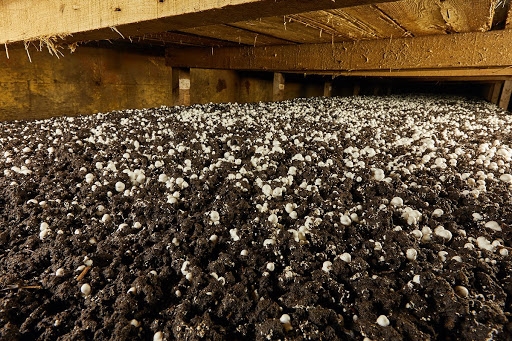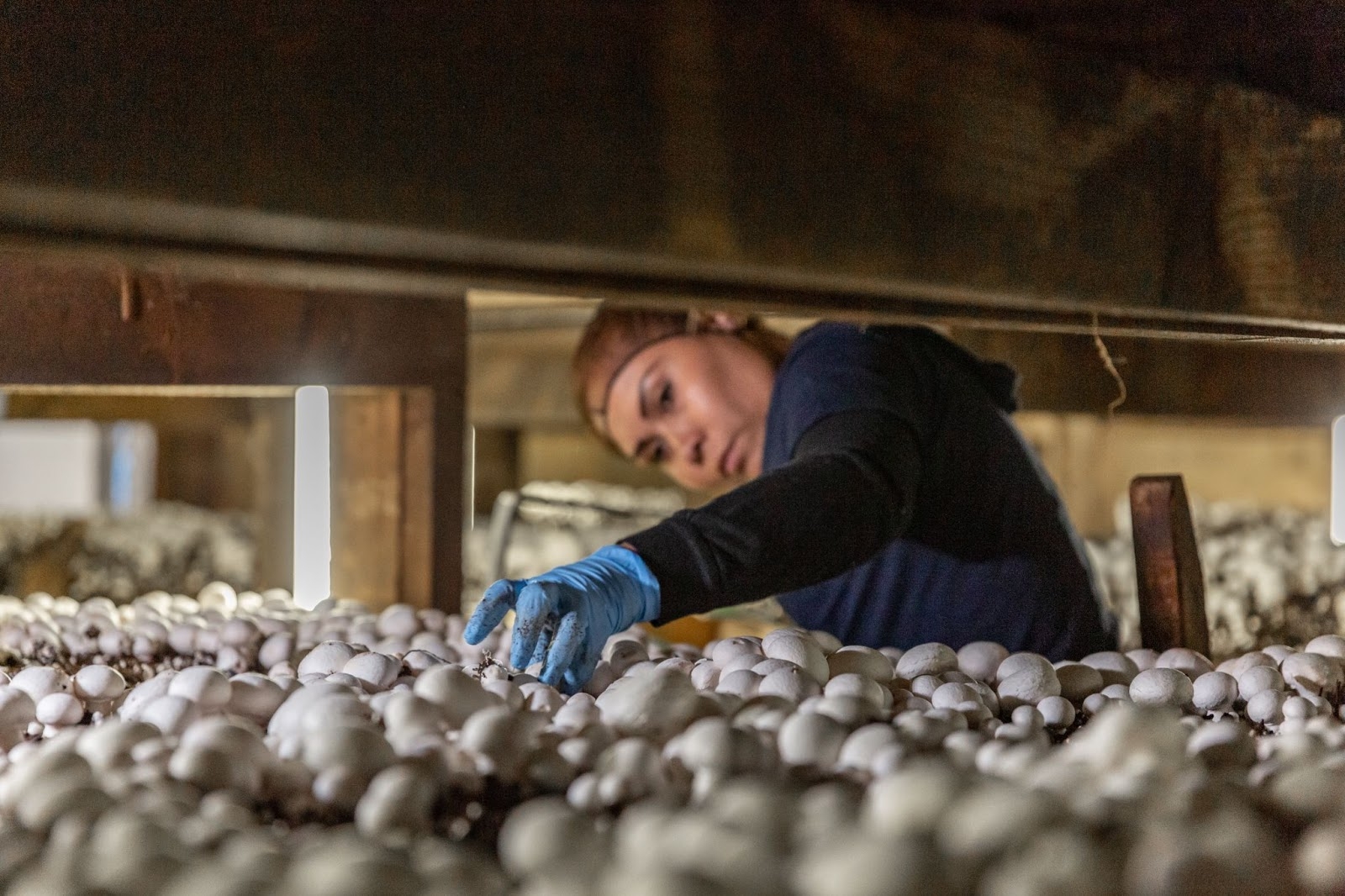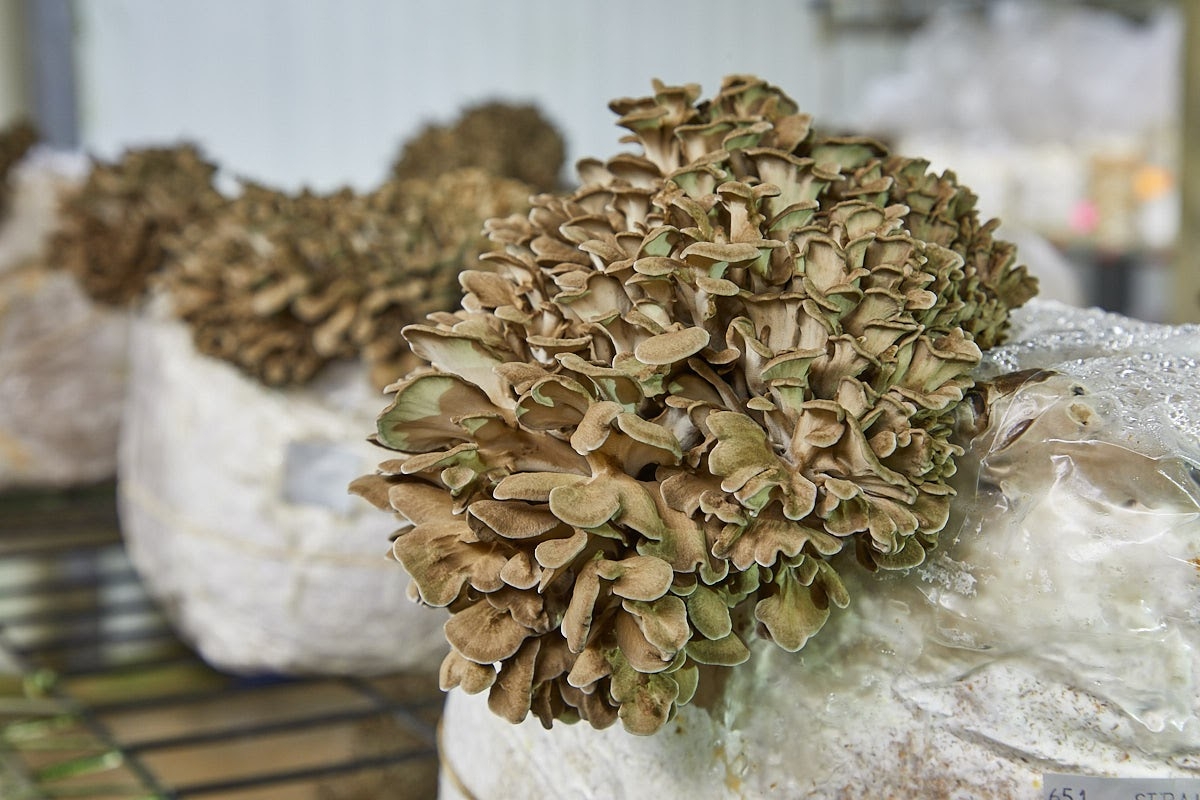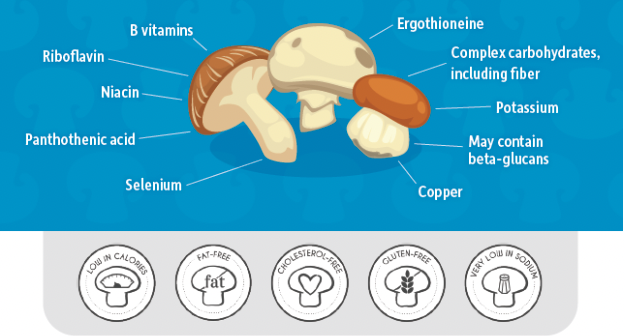All About Mushrooms
Mushroom Growing
Ever wonder how the mushrooms you see in the grocery store are grown? The white button, brown mushrooms and Portabella mushrooms actually start in a lab. Cereal grains are inoculated with mushroom spores and incubated until they develop into spawn or ‘mushroom seeds.’

Next, at the mushroom farm, growers carefully prepare the growing medium for mushroom production. Farmers combine materials like hay, straw, corn cobs, cocoa shells, and horse or chicken manure and place it in stacked wooden beds mixed with the spawn.
It takes about three weeks to produce the first mushrooms for harvest. Throughout the growing period, mushroom farmers play Mother Nature, manipulating water, airflow, temperature fluctuation and more to enhance mushroom growth.

Each mushroom is harvested by hand. They mature at a varying times, and will be harvested for two to three weeks to fit customers’ needs.

Specialty mushrooms like Shiitake, Oyster, Maiitake and others are grown a bit differently than the common white and brown button mushrooms. In general, these mushrooms are grown on logs or in bags The process of inoculating logs requires mycelium (spawn) to be placed inside the growing medium, whether natural or synthetic and then climate-controlled (temperature, humidity, light, and air). The ideal growing conditions for mushrooms are around 70 degrees Fahrenheit and greater than 90% humidity. Natural logs work well and oaks and maples serve as the best hosts. For natural logs, it is best if the log is newly cut so that it hasn’t dried out. Synthetic logs are just bagged mixes of sawdust, millet, rye, and water to keep feeding the mycelium.
Mushroom Sustainability
Growing mushrooms is a unique blend of recycling, science, and efficacy. This powerful combination makes them one of the most sustainably produced foods in the U.S. Mushroom growers are known as ‘ultimate recyclers’ for their ability to convert byproducts and waste from other sectors of agriculture—the corn cobs, hay, straw, manure, etc—into the compost to grow mushrooms. Because of this recycling of other agriculture crops and byproducts, mushroom farms have a smaller environmental footprint than almost any other farm.
- Today’s growers use smart management and production practices that use less than 2 gallons of water to produce one pound of button mushrooms--that’s about 32 8oz glasses of water to grow, harvest, and process an entire pound of mushrooms, compared with an average of 50 gallons of water per pound of other fresh produce items.
- Mushrooms are a fairly low-energy footprint corp. Producing 1 pound of button mushrooms takes 1.0 kilowatt hour (kwh) of electricity. This is the same amount of energy (1 kwh) as it takes to run a coffee maker for one hour each day.
- From the compost recipe all the way through to what you purchase in the store, 1 pound of mushrooms generates just 0.7 pounds of CO2 equivalents. By comparison, using 1 gallon of fuel emits nearly 20 pounds of CO2.
- One acre of land can produce 1 million pounds of mushrooms annually. In recent years, mushroom growers have produced just over 900 million pounds of Agaricus mushrooms each year. Put another way, 1 acre of land can produce enough mushrooms in a year to fill the length of nearly 4,700 football stadiums. Even more, 900 million pounds of mushrooms is enough to circle the circumference of the glob--mushroom cap to mushroom cap--19 times!
By any measure of water and energy inputs, and the low-CO2 emissions, mushrooms are a nutritious food that have a very small environmental footprint. More than being the "ultimate recyclers," mushroom growers are providing a sustainable, smart food source for a growing world population.
Nutrition
Full of powerful nutrients, mushrooms are increasingly begin named as a must-have on healthy plates, providing many of the same nutritional benefits as vegetables, as well as attributes commonly found in meat, beans, and grains.

Mushrooms and Research
When it comes to health, researchers are increasingly turning to mushrooms.
Fight Against Cancer: Early studies show mushrooms might be a factor in reducing levels of PSA in prostate cancer patients and help prevent recurrence of hormone-dependent breast cancers.
Anti-aging: Mushrooms contain ergothioeine and glutathione antioxidants which work to protect the body from stress that can cause visible signs of aging and may also help prevent symptoms of Parkinson’s and Alzheimer’s.
Cognitive Decline: Researchers are finding that less than one cup of cooked mushrooms twice per week can help to reduce the odds of mild cognitive decline.
Mushrooms and the Economy
Mushrooms are big business in Pennsylvania—they are the #1 cash crop in the state. From Philadelphia to Phoenix, chances are, if you eat mushrooms on your pizza, in your salads, or as part of your burgers, they were grown on a Pennsylvania mushroom farm. The state leads the nation in mushroom production, with more than 50 commercial mushroom farms growing more than 500 million pounds of mushrooms each year.
All in the Family
Pennsylvania mushrooms growers have William Swayne to thank for the long tradition of mushroom growing in the area. A successful florist in Kennett Square, PA, in the late 1800s, he conceived the idea of growing mushrooms beneath his greenhouse benches. The results were encouraging enough that he decided a separate building would make it possible to control the growing conditions for mushrooms. He built his first mushroom house in the are and made it a commercial success. Soon, others joined in their own mushroom growing businesses and the ‘Mushroom Capital of the World’ was born.
Today, many of the Pennsylvania mushroom farms are owned and operated by local families, and in many cases, are multi-generational mom and pop farms passed down to sons and daughters, nephews and cousins in third, fourth, or even fifth generations.

